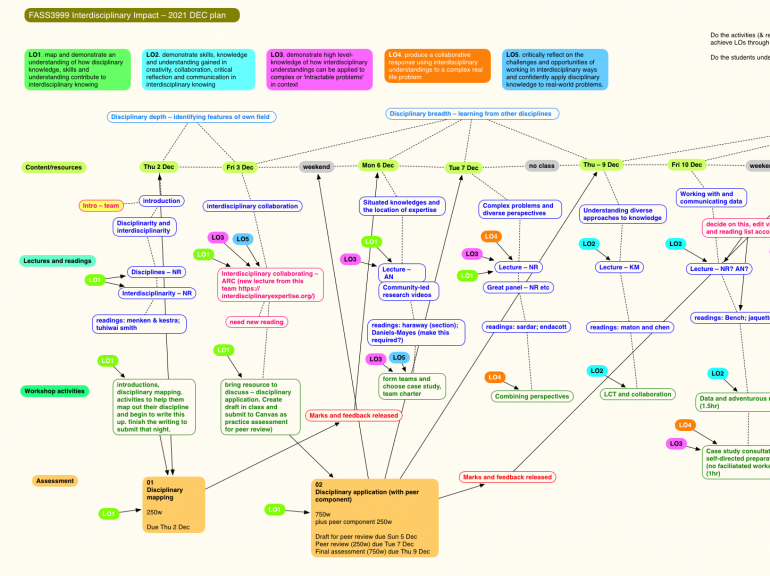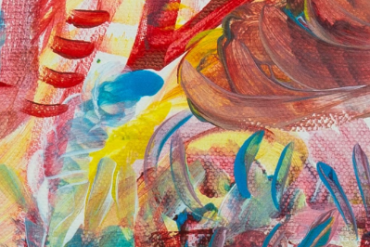In 2021 I had the fun challenge of coordinating the FASS3999 Interdisciplinary Impact December intensive. Storyboarding enabled me to address a number of existing challenges for students and educators alike and redesign the unit in collaboration with the teaching team to create a well-paced, well-supported and enjoyable experience for the students and the team.
FASS3999 is a large unit (~700 per semester) that is mandatory for undergraduate students with a Faculty of Arts and Social Sciences (FASS) major. I’d tutored in the unit for five teaching periods over two years, and as Postgraduate Teaching Fellow in 2021, I contributed to its development. Despite the collective care and hard work put into evolving FASS3999 since its pilot in 2018, a glance at Honi Soit and the USYD Rants 2.0 Facebook page made it clear that it’s not the most popular unit, with questions raised about its relevance, and dissatisfaction with the group project which is a major component of the workload. With only 11 teaching days across the 2022 December intensive period, at the end of the tiring second year of the pandemic, I wanted to attend to the unit design so the intensive could be a good experience for everyone.
There were several challenges to address: the unit had to have the same assessments as the in-semester version; core concepts had to be covered in a compressed timeframe to support those assessments; the ~65 students had to form teams and collaborate to produce a group project before the end of the teaching period, and; the submission and marking timing for assessments had to allow for formative feedback, as well as for simple extensions and academic plans, and the holiday break.
Having attended the invaluable Modular Professional Learning Framework (MPLF) module M04 Curriculum design and constructive alignment and learned about storyboarding, I used this approach to manage the relatively complex piece of unit redesign needed for the intensive.
Starting with the learning outcomes, I mapped these to the assessments and then arranged the course materials to support the learning outcomes assessed. I was fortunate to have the pre-recorded lectures from the semester to use, along with some new ones thanks to the generosity of colleagues who created these at short notice. This made it possible to have the course materials on the Canvas site and available to students before the start of the intensive. Making the content available asynchronously and in advance allowed students to engage at their convenience, and to make the most of the 11 x 2.5 hour synchronous Zoom workshops to collaborate with their teammates and receive guidance from the tutors.
In order to allow for formative feedback, I divided the first assignment (40%) into three stages, with the first stage completed in the workshop and submitted on the first day of the intensive (with the option to complete it in advance if they preferred). The second stage was then submitted as a draft, and each student was allocated a peer’s draft to review. This review was an assessed component and was completed in time for the student to use it to improve their final draft for submission. A marking schedule of four days for each of the three assignment stages was agreed upon by the teaching team, including formative feedback for each. The nicest part of including assessed peer review (despite the trickiness of achieving this in Canvas!) was that each student received 250 words of high-quality peer feedback on their draft (much more than we in the teaching team would have had the time to do), as well as learning through writing a review for a peer. By the evening of the seventh teaching day, the cohort had been supported to complete and submit their assignment and had received their marks and feedback, leaving them clear to focus the remainder of the intensive on their group project. This project was submitted, and marked, before the holiday break, giving the students feedback that fed into their final reflective assignment, due in January.
Storyboarding allowed all the components, their connections, and their timing to be mapped out, discussed with the teaching team, and optimised, resulting in a unit design which supported the students in their learning and made the most of the a/synchronous environments and the timeframe, with a manageable teaching workload.
The feedback from the teaching team and the students were positive, especially around the assessment design, the Canvas site and even the group project, and the USS reflected satisfaction, enjoyment and students feeling supported.

edTech tools for storyboarding
I made the FASS3999 storyboard using Scapple, and there are many other similar tech tools available. Some free ones include Google Jamboard, Lucidchart, Coggle, Miro and Mural.
To learn more
Storyboarding is helpful not only in unit design, but also in designing components such as assessments or tutorial activities, by enabling you to work in overview to ensure all aspects of the design are considered.
To learn more, check out M04 Curriculum design and constructive alignment.





